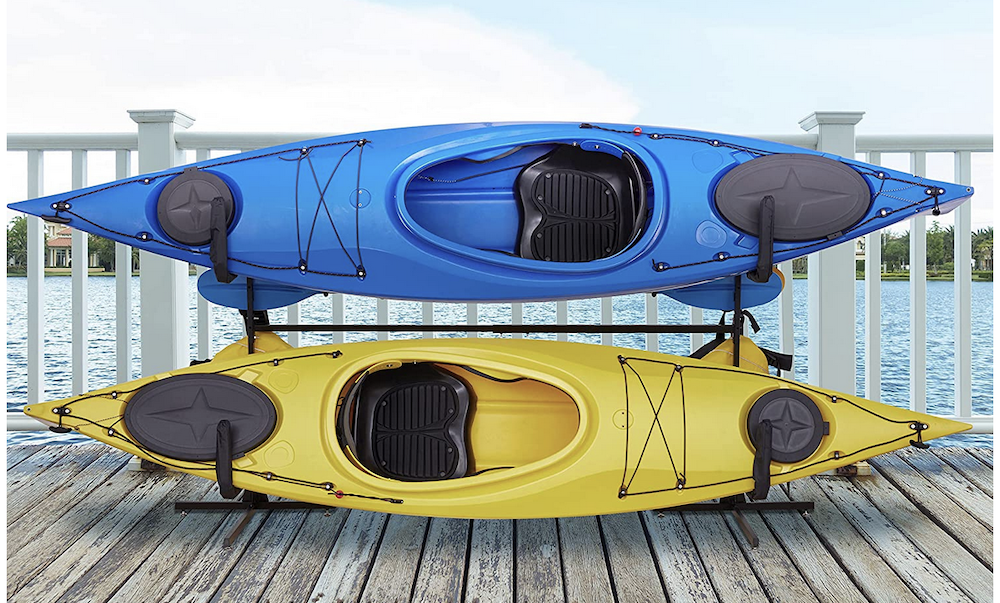
Owning a kayak is akin to holding the keys to aquatic adventures. From tranquil lakes to thrilling river currents, the joy of kayaking is endless. However, the importance of proper kayak storage can’t be overstated. Improper storage can lead to a shorter lifespan for your kayak or, even worse, structural damage. This article will give you tips on how to store and care for your kayak, so it remains in tip-top shape for years to come.
Where to store your kayak
Choosing the right storage spot for your kayak is crucial not only for its longevity but also for ease of access and security. This section will delve into the various considerations to keep in mind when determining the best place to store your kayak, ensuring it remains safe and ready for your next adventure.
Factors to consider:
- Space: Consider the amount of space available. Kayaks can be pretty lengthy, so make sure to measure out the space you’re considering.
- Protection from elements: Ensure your kayak is shielded from UV rays, moisture, and extreme temperatures. These can lead to fading, cracks, and hull deformation.
- Security concerns: Consider how you can secure your kayak in its storage space. Think about installing motion sensors, alarms, or even GPS trackers for added peace of mind.
Indoor vs. outdoor storage
Deciding between indoor and outdoor storage for your kayak can often come down to balancing convenience, space, and protection.
- Indoor: Spaces such as garages, basements, or sheds, inherently offer more protection. Within these confines, your kayak enjoys a consistent climate, away from the unpredictable weather changes. This consistency can vastly increase its durability, not to mention the decreased risks from potential animal interference or accidental outdoor damage.
- Outdoor: Outdoor storage might be your only option if space is a constraint. In such cases, it’s important to take specific measures. A shaded spot or a good quality cover can help reduce UV exposure. However, to protect your kayak from rain or snow, using a tarp is recommended. Elevate your kayak slightly off the ground to prevent water pooling and potential damage. While outdoor storage may expose your kayak to more risks, proper precautions and regular maintenance can help mitigate these issues and keep your kayak safe and ready to hit the waters whenever you are.
How to store your kayak

Securing the perfect spot for your kayak is just the beginning; understanding how to store it correctly is the next step. Proper storage ensures that your kayak maintains its shape, integrity, and performance over time. The two most popular storage methods are using a rack or suspending your kayak:
On a rack
Kayak racks are the go-to for many, and for good reason:
- Adaptability: They come in various sizes and designs, catering to single or multiple kayak households.
- Safety: Many modern racks offer padded touchpoints, ensuring the kayak hull remains scratch-free.
- Flexibility: Racks can be stationed indoors or outdoors, making them a versatile choice.
Suspended
When floor space is a luxury, looking up can be the solution.
- Advanced hoisting: Contemporary pulley systems, combined with strong straps, simplify the suspension process, regardless of kayak size.
- Wall solutions: Wall brackets, anchored securely, can be an efficient and space-saving method. Opt for padded brackets to minimize any risk of scratches or pressure points.
Tips for kayak maintenance

While the right storage plays a pivotal role in your kayak’s longevity, it’s the ongoing care that truly keeps it at its best. Regular maintenance doesn’t just improve the life expectancy of your vessel; it also ensures optimal performance on the water. The environment, combined with the natural wear and tear from use, can gradually degrade your kayak if unchecked. Here are some essential care tips:
- Clean before storing: Always rinse off your kayak after use, removing any dirt, salt, or debris. This prevents long-term damage and ensures it’s ready for your next adventure.
- Use a cover: Invest in a high-quality, breathable kayak cover. This will shield your vessel from UV damage and can prevent moisture build-up, which could lead to mold or mildew.
- Check regularly: Whether you’re in the midst of kayaking season or it’s the dead of winter, periodically inspect your kayak. This can help you spot any potential issues early on.
Embrace the waves with confidence and care
Storing your kayak correctly ensures that when the water calls, your vessel is ready to offer a safe and enjoyable experience. By considering factors like location, storage methods, and routine care, you can keep your kayak in shipshape for years to come. Whether you’re a seasoned paddler or just starting, treat your kayak with care, and it’ll provide you with endless memories in return.





